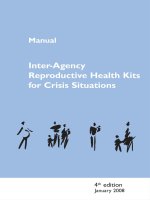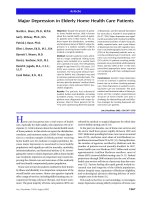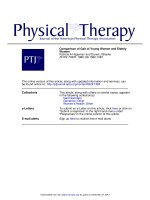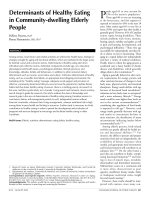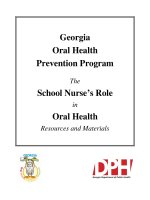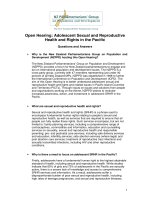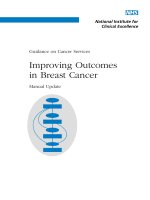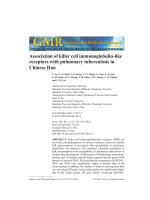Preventing Falls in Elderly Persons pdf
Bạn đang xem bản rút gọn của tài liệu. Xem và tải ngay bản đầy đủ của tài liệu tại đây (105.39 KB, 8 trang )
clinical practice
The
new england journal
of
medicine
n engl j med
348;1
www.nejm.org january
2, 2003
42
This
Journal
feature begins with a case vignette highlighting a common clinical problem.
Evidence supporting various strategies is then presented, followed by a review of formal guidelines,
when they exist. The article ends with the author’s clinical recommendations.
Preventing Falls in Elderly Persons
Mary E. Tinetti, M.D.
From the Departments of Internal Medicine
and of Epidemiology and Public Health,
Yale University School of Medicine, 333
Cedar St., P.O. Box 208025, New Haven, CT
06520-8025, where reprint requests can be
addressed to Dr. Tinetti.
A 79-year-old woman with a history of congestive heart failure, arthritis, depression,
and difficulty sleeping presents for a follow-up visit. She takes several prescription
medications, including an antidepressant, a diuretic, an angiotensin-converting–
enzyme inhibitor, and a beta-blocker, as well as over-the-counter sleep and allergy
medications. Her chronic conditions appear to be stable. Her daughter reports that
the patient has fallen twice during the past six months. What can be done to prevent
future falls?
More than one third of persons 65 years of age or older fall each year, and in half of
such cases the falls are recurrent.
1,2
Approximately 1 in 10 falls results in a serious
injury, such as hip fracture, other fracture, subdural hematoma, other serious soft-
tissue injury, or head injury.
3-5
Falls account for approximately 10 percent of visits to
the emergency department and 6 percent of urgent hospitalizations among elderly
persons.
4,6
Independently of other health conditions, falls are associated with restrict-
ed mobility; a decline in the ability to carry out activities such as dressing, bathing, shop-
ping, or housekeeping; and an increased risk of placement in a nursing home.
7-9
Although a few falls have a single cause, the majority result from interactions be-
tween long-term or short-term predisposing factors and short-term precipitating fac-
tors in a person’s environment.
1-5
Each of the following conditions has been shown to
increase the subsequent risk of falling in two or more observational studies: arthritis;
depressive symptoms; orthostasis; impairment in cognition, vision, balance, gait, or
muscle strength; and the use of four or more prescription medications. Furthermore,
the risk of falling consistently increases as the number of these risk factors increases.
1,2
The risk of falling increased in a cohort of elderly persons living in the community, for
example, from 8 percent among those with no risk factors to 78 percent among those
with four or more risk factors.
1
Although there is a clear relation between falling and the use of a higher number of
medications, the risks associated with individual classes of drugs have been more var-
iable.
10,11
To date, serotonin-reuptake inhibitors, tricyclic antidepressants, neuroleptic
agents, benzodiazapines, anticonvulsants, and class IA antiarrhythmic medications
have been shown to have the strongest link to an increased risk of falling.
10-12
During the month after hospital discharge, the risk of falling is high, particularly
among elderly persons frail enough to require home health care.
13
Other periods of
high risk include those in which there are episodes of acute illness or exacerbations of
chronic illness.
As discussed in the next section of this article, several single and multifactorial,
health care–based strategies have proved effective in reducing the rate of falling in clin-
the clinical problem
Copyright © 2003 Massachusetts Medical Society. All rights reserved.
Downloaded from www.nejm.org at UNIV OF TEXAS on May 2, 2006 .
n engl j med
348;1
www.nejm.org january
2, 2003
clinical practice
43
ical trials.
14-21
However, implementation of these
approaches for the prevention of falling may be
complicated, for at least two reasons. First, clini-
cians are more experienced at managing discrete
diseases than at managing multifactorial condi-
tions, such as falling. Second, although many
components of an effective fall-prevention strate-
gy are relatively straightforward, others require
tradeoffs and the weighing of risks and benefits.
Perhaps the most complicated component of a
strategy to prevent falls involves reduction in the
use of medications. Medications may be appropri-
ately recommended for the treatment of a disease,
but they also have adverse effects; falling is one
of the most common adverse events related to
drugs.
22-24
Many elderly patients have several
chronic conditions for which multiple medications
are prescribed, further increasing the associated
risks, including falling.
assessment and intervention
Because falls result from various combinations of
factors, an effective and efficient clinical strategy
for risk assessment and management must ad-
dress many predisposing and precipitating factors.
However, a clinically sensible strategy can be extrap-
olated from the available clinical-trial data, aug-
mented by observational data from well-designed
studies.
1-5,10-21
A rational approach to the prevention of falls is
presented in Figure 1. Because elderly persons may
not volunteer the information, physicians should,
on at least a yearly basis, ask their elderly patients
about any falls and ask about and look for any diffi-
culties with balance or gait. Brief screens such as
the “Get-Up and Go” test, which involves looking
for unsteadiness as the patient gets up from a chair
strategies and evidence
Figure 1. Algorithm Summarizing the Clinical Approach to the Prevention of Falls among Elderly Persons Living in the Community.
The algorithm is based on available evidence.
Ask all patients ≥75 years old about falls and balance
or gait difficulties. Observe the patients getting into
and out of a chair and walking.
Recommend participation in an
exercise program that includes
balance and strength training
Assessment of predisposing and precipitating factors,
followed by interventions suggested by the results
of detailed assessment
No falls and no
balance or gait
difficulties
One fall and no
balance or gait
difficulties
Two or more falls
or balance or gait
difficulties
Copyright © 2003 Massachusetts Medical Society. All rights reserved.
Downloaded from www.nejm.org at UNIV OF TEXAS on May 2, 2006 .
n engl j med
348;1
www.nejm.org january 2,
2003
The
new england journal
of
medicine
44
without using his or her arms, walks a few meters,
and returns, is easily incorporated into short clinical
encounters.
25,26
Other assessments provide more
specific information about balance and gait abnor-
malities.
27
Although there is no consensus about
the optimal time to initiate screening, the rate of
falling and the prevalence of risk factors for falling
increase steeply after the age of 70 years.
1-4
Single-intervention strategies that have proved
effective among elderly persons deemed at risk for
falling, either because of the presence of a known
risk factor or because of a history of falls, include
professionally supervised balance and gait training
and muscle-strengthening exercise; gradual discon-
tinuation of psychotropic medications; and modi-
fication of hazards in the home after hospital dis-
charge (Table 1).
14-21
In one study, tapering and
discontinuation of psychotropic medications, in-
cluding benzodiazepines, other sleep medications,
neuroleptic agents, and antidepressants, over a 14-
week period were associated with a 39 percent re-
duction in the rate of falling.
17
Although nonspe-
cific advice about modification of home hazards
directed at untargeted groups of elderly persons has
not proved effective, standardized assessment of
home hazards by an occupational therapist, along
with specific recommendations and follow-up after
hospital discharge, was associated with a 20 percent
reduction in the risk of falling.
14,18
The most com-
monly recommended modifications in that study
were the removal of rugs, a change to safer foot-
wear, the use of nonslip bathmats, the use of
lighting at night, and the addition of stair rails. Ad-
herence to the recommended interventions ranged
from 19 percent for the installation of stair rails to
75 percent for the use of bathmats.
18
Whereas multifactorial assessments not linked
to targeted interventions have been ineffective in
preventing falls,
14,28-30
the most consistently suc-
cessful approach to prevention has been multifac-
torial assessment, followed by interventions target-
ing the identified risk factors.
19-21
Such targeted
assessment and management strategies have been
shown to reduce the occurrence of falling by 25 to
39 percent (Table 1). Successful components of
these interventions include review and possible re-
duction of medications; balance and gait training,
muscle-strengthening exercise; evaluation of pos-
tural blood pressure, followed by strategies to re-
duce any decreases in postural blood pressure;
home-hazard modifications; and targeted medical
and cardiovascular assessments and treatments.
Ascertainment of the circumstances surrounding
previous falls may reveal precipitating factors, such
as environmental hazards, risks associated with the
activity at the time of the fall, and acute host factors,
such as acute illness or immediate effects of medi-
cation, that may be amenable to intervention.
Specific recommendations for assessment and
intervention are summarized in Table 2. The assess-
ments can be performed either by the patient’s
usual physician or by a geriatric specialist. All med-
ications, including over-the-counter medications,
should be thoroughly reviewed and considered for
possible elimination or dose reduction; the goal
should be to maximize the overall health and func-
tional benefits of the medications while minimiz-
ing their adverse effects, such as falls. Psychotropic
medications warrant particular attention, since there
is very strong evidence that use of these medica-
tions is linked to the occurrence of falls.
10,11,17
Re-
ducing the total number of medications to four or
* The trials are those reported in the Cochrane review
14
that included at least six
months of follow-up and involved persons living in the community. Among the
strategies that have not been shown to be effective are multifactorial risk assess-
ment without targeted management (none of three trials with positive results
28-30
),
low-intensity general exercise programs (none of seven trials with positive
results
31-37
), and cognitive–behavioral, educational, and self-management pro-
grams (one of six trials with positive results
38-43
).
† Positive results were defined as relative risks with 95 percent confidence intervals
that did not include 1.
15,16,19-21
‡ Participants were recruited from clinical settings, and interventions were carried
out by health care professionals. Participants had reported previous falls or balance
or gait difficulties or had one or more risk factors for falling.
§ The specific assessments and interventions varied among the trials. The trial per-
sonnel directed or carried out specific interventions on the basis of the results of
the assessments.
¶ Participants were recruited from community sites, and interventions were not car-
ried out by health care professionals. Participants were not recruited on the basis of
previous falls, balance or gait difficulties, or risk factors.
44,45
Table 1. Strategies Shown in Randomized Clinical Trials to Be Effective
in Reducing the Occurrence of Falls among Elderly Persons Living
in the Community.*
Strategy
Estimated
Risk
Reduction
No. of Trials
with Positive
Results†
%
Health care–based strategy‡
Balance and gait training and strengthening exercise
Reduction in home hazards after hospitalization
Discontinuation of psychotropic medication
Multifactorial risk assessment with targeted
management§
14–27
19
39
25–39
2 of 3
1 of 1
1 of 1
3 of 3
Community-based strategy¶
Specific balance or strength exercise programs
29–49 2 of 2
Copyright © 2003 Massachusetts Medical Society. All rights reserved.
Downloaded from www.nejm.org at UNIV OF TEXAS on May 2, 2006 .
n engl j med
348;1
www.nejm.org january
2, 2003
clinical practice
45
fewer, if feasible, has also been demonstrated to re-
duce the risk of falling.
47
When assessed appropriately, clinically signifi-
cant postural hypotension is detected in up to 30
percent of elderly persons.
46,48
Moreover, some
elderly persons with postural hypotension do not
report symptoms, such as dizziness or lighthead-
edness.
46
Evidence from trials of single and multi-
factorial interventions suggests that all elderly per-
sons who have any abnormalities on balance and
gait testing should be referred to physical therapy
for a comprehensive evaluation as well as rehabili-
tation.
15,16,19-21
In addition to direct observation of the elderly
* Recommendation of this assessment is based on observational data that the finding is associated with an increased risk of falling.
† Recommendation of this assessment is based on one or more randomized controlled trials of a single intervention.
‡ Recommendation of this assessment is based on one or more randomized controlled trials of a multifactorial intervention strat-
egy that included this component.
Table 2. Recommended Components of Clinical Assessment and Management for Older Persons Living
in the Community Who Are at Risk for Falling.
Assessment and Risk Factor Management
Circumstances of previous falls* Changes in environment and activity to reduce the likelihood
of recurrent falls
Medication use
High-risk medications (e.g., benzodiazepines, other sleep-
ing medications, neuroleptics, antidepressants, anti-
convulsants, or class IA antiarrhythmics)*†‡
Four or more medications‡
Review and reduction of medications
Vision*
Acuity <20/60
Decreased depth perception
Decreased contrast sensitivity
Cataracts
Ample lighting without glare; avoidance of multifocal glasses
while walking; referral to an ophthalmologist
Postural blood pressure (after ≥5 min in a supine position,
immediately after standing, and 2 min after standing)‡
≥20 mm Hg (or ≥20%) drop in systolic pressure, with or
without symptoms, either immediately or after 2 min
of standing
Diagnosis and treatment of underlying cause, if possible; re-
view and reduction of medications; modification of salt re-
striction; adequate hydration
46
; compensatory strategies
(e.g., elevation of head of bed, rising slowly, or dorsiflexion
exercises); pressure stockings; pharmacologic therapy if
the above strategies fail
Balance and gait†‡
Patient’s report or observation of unsteadiness
Impairment on brief assessment (e.g., the Get-Up and
Go test
25,26
or performance-oriented assessment
of mobility
27
)
Diagnosis and treatment of underlying cause, if possible; re-
duction of medications that impair balance; environmen-
tal interventions; referral to physical therapist for assistive
devices and for gait and progressive balance training
Targeted neurologic examination
Impaired proprioception*
Impaired cognition*
Decreased muscle strength†‡
Diagnosis and treatment of underlying cause, if possible; in-
crease in proprioceptive input (with an assistive device or
appropriate footwear that encases the foot and has a low
heel and thin sole); reduction of medications that impede
cognition; awareness on the part of caregivers of cognitive
deficits; reduction of environmental risk factors; referral to
physical therapist for gait, balance, and strength training
Targeted musculoskeletal examination: examination of legs
(joints and range of motion) and examination of feet*
Diagnosis and treatment of the underlying cause, if possible;
referral to physical therapist for strength, range-of-motion,
and gait and balance training and for assistive devices; use
of appropriate footwear; referral to podiatrist
Targeted cardiovascular examination†
Syncope
Arrhythmia (if there is known cardiac disease, an abnormal
electrocardiogram, and syncope)
Referral to cardiologist; carotid-sinus massage (in the case of
syncope)
Home-hazard evaluation after hospital discharge†‡ Removal of loose rugs and use of nightlights, nonslip bath-
mats, and stair rails; other interventions as necessary
Copyright © 2003 Massachusetts Medical Society. All rights reserved.
Downloaded from www.nejm.org at UNIV OF TEXAS on May 2, 2006 .
n engl j med
348;1
www.nejm.org january 2,
2003
The
new england journal
of
medicine
46
person while he or she stands from a sitting posi-
tion and walks, a targeted neurologic examination
may reveal potentially treatable causes of balance
or gait impairment. Proprioceptive impairment due
to a neuropathy, for example, is a common cause of
balance impairment in elderly persons. A decreased
sensation of vibration, a frequent but abnormal
finding in this population, is a more sensitive mark-
er of neuropathy than a decrease in the sensation of
position. A gait that worsens when the eyes are
closed and improves when minor support is given
by the examiner is a further clue to proprioceptive
problems.
Persons who have fallen should be asked about
loss of consciousness. Given recent evidence that
some elderly persons are unaware of episodes of
loss of consciousness, syncope should also be con-
sidered in those who report “just going down.”
49
laboratory tests and imaging
The role of laboratory and ancillary testing in the
prevention of falls has not been well studied. Lab-
oratory tests that might reasonably be performed
in all persons at risk for falling include a complete
blood count; measurement of serum electrolytes,
blood urea nitrogen, creatinine, glucose, and vita-
min B
12
; and assessment of thyroid function. These
tests are relatively inexpensive, and abnormal re-
sults, which are likely to be prevalent, suggest the
presence of a treatable entity. Other tests should
be reserved for persons in whom the presence of
an abnormality is suggested by the history and re-
sults of physical examination. Neuroimaging is
indicated only if there is a head injury or new, fo-
cal neurologic findings on the physical examina-
tion or if a central nervous system process is sus-
pected on the basis of the history or examination
results. Electroencephalography is rarely helpful
and is indicated only if there is a high degree of
clinical suspicion of seizure. Similarly, ambulatory
cardiac monitoring is helpful only rarely; in elder-
ly persons, this technique is associated with fre-
quent false positives and false negatives.
50
An eval-
uation for arrhythmia is warranted only if there is
clinical evidence of this diagnosis, such as a known
history of cardiac events or an abnormal electro-
cardiogram.
education and other measures
Though repeatedly shown to be ineffective as a sole
intervention,
38-43
education is an important com-
ponent of strategies to manage the risk of falling.
The person at risk and his or her family members
should be educated about the multifactorial nature
of most falls, about the specific risk factors for fall-
ing that are present, and about recommended inter-
ventions. Persons at risk for falling who live alone or
who spend large amounts of time alone should be
taught what to do if they fall and cannot get up, and
they should have a personal emergency-response
system or a telephone that is accessible from the
floor.
For healthy elderly persons who have not fallen
and who do not report or show balance or gait dif-
ficulties, the available evidence suggests that com-
munity-based exercise programs not supervised by
health care professionals that include progressive
balance-training and strengthening components
may reduce the likelihood of a fall (Table 1).
14,44,45
Nonspecific, general exercise programs,
31-37
self-
management and cognitive–behavioral approach-
es,
38-43
and home-hazard modifications for older
persons without a history of falling or recent hospi-
talization have not proved effective.
14,38,51
Low bone density increases the risk of hip and
other fractures and should be identified and treated.
The guidelines of the National Osteoporosis Foun-
dation recommend that all women 65 years of age
or older and women less than 65 years of age who
are postmenopausal and who have additional risk
factors for osteoporotic fractures (such as a lean
habitus, a history of fractures, or a history of ciga-
rette smoking) should undergo bone mineral den-
sity measurement to assess the risk of fractures and
to ascertain whether pharmacologic or nonpharma-
cologic treatment would be appropriate.
52
A discus-
sion of the prevention and treatment of osteoporosis
is beyond the scope of this article, but information
is available from the National Osteoporosis Foun-
dation ( />
52
In addi-
tion to other therapies, hip protectors appear to
reduce the risk of hip fracture among persons at
high risk.
53
It remains to be determined whether the strategies
that have proved effective in reducing the occur-
rence of falls are equally effective in reducing the
most serious injuries that occur as a result of fall-
ing, such as fractures and head injuries. Observa-
tional data suggest that the risk factors for falls and
for serious injuries due to falls are similar
3-5
; trials
of fall-prevention strategies to date, however, have
areas of uncertainty
Copyright © 2003 Massachusetts Medical Society. All rights reserved.
Downloaded from www.nejm.org at UNIV OF TEXAS on May 2, 2006 .
n engl j med
348;1
www.nejm.org january
2, 2003
clinical practice
47
not had sufficient power to detect whether they have
an effect on the incidence of serious injury.
14
The exercise programs found to be effective have
been short term, usually lasting one year or less.
Since most of the benefits of exercise are main-
tained only as long as the exercise regimen is main-
tained, methods for enhancing long-term adher-
ence are needed. The optimal intensity, frequency,
and type of exercise needed to minimize the risk of
falling and of incurring injury while maximizing
mobility remain to be determined.
Studies suggest that the number of medica-
tions prescribed can be reduced safely and effec-
tively.
14,47,54
However, practical methods are need-
ed to balance the benefits of medications for the
treatment of specific diseases with the risk of ad-
verse events, including falls, in elderly persons.
There may be an overlap between falling and the
presence of syncope: preliminary data suggest that
patients who have had recurrent, unexplained falls
and who have bradycardia in response to carotid-
sinus stimulation have fewer falls with cardiac pac-
ing.
49
Until these findings are confirmed in clinical
trials, however, pacemaker therapy for the preven-
tion of unexplained falls cannot be recommended.
The U.S. Preventive Services Task Force recom-
mends that all persons 75 years of age or older, as
well as those 70 to 74 years of age who have a known
risk factor, be counseled about specific measures to
prevent falls.
55
It also recommends that elderly per-
sons at high risk for falling receive individualized,
multifactorial interventions in settings where ade-
quate resources to deliver such services are available.
The American Geriatrics Society, the British Ger-
iatrics Society, and the American Academy of Or-
thopaedic Surgeons have released joint, evidence-
based guidelines for the prevention of falls.
56
They
recommend that all elderly patients be asked about
any falls that have occurred during the previous year
and that they undergo a quick test of gait and bal-
ance. The age at which screening should begin is
not stipulated in the guidelines. A more compre-
hensive assessment, followed by a multifactorial
intervention strategy, is recommended for patients
who report recurrent falls, who present after a fall,
or who have difficulties with balance or gait.
All patients 75 years of age or older (or 70 years of
age or older, if they are known to be at increased
risk for falling) should be asked whether they have
a history of falls and, if they do, should be carefully
questioned about the circumstances of the falls and
examined for potential risk factors. Strategies in-
volving multifactorial assessment and intervention
effectively reduce the rate of falling.
In the case of the patient described in the vi-
gnette, a review of the circumstances of her previ-
ous falls may identify high-risk activities that
should be discontinued, such as carrying laundry
up and down stairs. Her depressive symptoms
should be reviewed to assess the tradeoff between
the amelioration of depression and the risk of
falling associated with her use of antidepressant
medication. Efforts should be made to encourage
the patient to eliminate over-the-counter sleep
and allergy medications, both of which have anti-
cholinergic effects and thus probably contribute
to her risk of falling. Because her congestive heart
failure is stable, it may be possible to reduce the
dose of her diuretic or her cardiac medications.
Any evidence of postural hypotension would fur-
ther support an attempt to reduce the dose of her
cardiac medications. Adequate hydration should
be ensured, while avoiding fluid overload or seri-
ous hyponatremia.
57
If, as is likely, she has any
balance or gait problems, she should be referred
to a physical therapist who will train her in the use
of an appropriate assistive device, such as a cane
or walker, and who will prescribe a progressive
program of balance and gait training and muscle
strengthening. If her bone mineral density is low,
I would advise her to wear hip protectors and to
take calcium and vitamin D supplements, along
with a bisphosphonate. These interventions will
reduce by one third her risk of falling and of sus-
taining a hip fracture.
Additional information on the prevention of
falls, including educational material for patients,
can be obtained from the National Institute on Ag-
ing (), the Centers for Dis-
ease Control and Prevention (),
and the American Geriatrics Society (http://www.
americangeriatrics.org/education/forum).
guidelines
conclusions
and recommendations
Copyright © 2003 Massachusetts Medical Society. All rights reserved.
Downloaded from www.nejm.org at UNIV OF TEXAS on May 2, 2006 .
n engl j med
348;1
www.nejm.org january 2,
2003
The
new england journal
of
medicine
48
references
1.
Tinetti ME, Speechley M, Ginter SF. Risk
factors for falls among elderly persons liv-
ing in the community. N Engl J Med 1988;
319:1701-7.
2.
Nevitt MC, Cummings SR, Kidd S,
Black D. Risk factors for recurrent nonsyn-
copal falls: a prospective study. JAMA 1989;
261:2663-8.
3.
Nevitt MC, Cummings SR, Hudes ES.
Risk factors for injurious falls: a prospective
study. J Gerontol 1991;46:M164-M170.
4.
Sattin RW. Falls among older persons: a
public health perspective. Annu Rev Public
Health 1992;13:489-508.
5.
Tinetti ME, Doucette J, Claus E, Marot-
toli RA. Risk factors for serious injury dur-
ing falls by older persons in the community.
J Am Geriatr Soc 1995;43:1214-21.
6.
Runge JW. The cost of injury. Emerg
Med Clin North Am 1993;11:241-53.
7.
Kosorok MR, Omenn GS, Diehr P, et al.
Restricted activity days among older adults.
Am J Public Health 1992;82:1263-7.
8.
Tinetti ME, Williams CS. The effect of
falls and fall injuries on functioning in com-
munity-dwelling older persons. J Gerontol
A Biol Sci Med Sci 1998;53:M112-M119.
9.
Idem.
Falls, injuries due to falls, and the
risk of admission to a nursing home. N Engl
J Med 1997;337:1279-84.
10.
Leipzig RM, Cumming RG, Tinetti ME.
Drugs and falls in older people: a systematic
review and meta-analysis. I. Psychotropic
drugs. J Am Geriatr Soc 1999;47:30-9.
11.
Idem.
Drugs and falls in older people: a
systematic review and meta-analysis. II.
Cardiac and analgesic drugs. J Am Geriatr
Soc 1999;47:40-50.
12.
Thapa PB, Gideon P, Cost TW, Milam
AB, Ray WA. Antidepressants and the risk of
falls among nursing home residents. N Engl
J Med 1998;339:875-82.
13.
Mahoney J, Sager M, Dunham NC,
Johnson J. Risk of falls after hospital dis-
charge. J Am Geriatr Soc 1994;42:269-74.
14.
Gillespie LD, Gillespie WJ, Robertson
MC, Lamb SE, Cumming RG, Rowe BH.
Interventions for preventing falls in elderly
people. Cochrane Database Syst Rev 2001;3:
CD000340.
15.
Campbell AJ, Robertson MC, Gardner
MM, Norton RN, Tilyard MW, Buchner DM.
Randomised controlled trial of a general
practice programme of home based exer-
cises to prevent falls in elderly women. BMJ
1997;315:1065-9.
16.
Robertson MC, Devlin N, Gardner MM,
Campbell AJ. Effectiveness and economic
evaluation of a nurse delivered home exer-
cise programme to prevent falls. 1. Ran-
domised controlled trial. BMJ 2001;322:
697-701.
17.
Campbell AJ, Robertson MC, Gardner
MM, Norton RN, Buchner DM. Psycho-
tropic medication withdrawal and a home-
based exercise program to prevent falls: a
randomized, controlled trial. J Am Geriatr
Soc 1999;47:850-3.
18.
Cumming RG, Thomas M, Szonyi G, et
al. Home visits by an occupational therapist
for assessment and modification of environ-
mental hazards: a randomized trial of falls
prevention. J Am Geriatr Soc 1999;47:1397-
402.
19.
Close J, Ellis M, Hooper R, Glucksman
E, Jackson S, Swift C. Prevention of falls in
the elderly trial (PROFET): a randomised
controlled trial. Lancet 1999;353:93-7.
20.
Wagner EH, LaCroix AZ, Grothaus L, et
al. Preventing disability and falls in older
adults: a population-based randomized trial.
Am J Public Health 1994;84:1800-6.
21.
Tinetti ME, Baker DI, McAvay G, et al. A
multifactorial intervention to reduce the risk
of falling among elderly people living in the
community. N Engl J Med 1994;331:821-7.
22.
Gray SL, Mahoney JE, Blough DK.
Adverse drug events in elderly patients receiv-
ing home health services following hospi-
tal discharge. Ann Pharmacother 1999;33:
1147-53.
23.
Field TS, Gurwitz JH, Avorn J, et al. Risk
factors for adverse drug events among nurs-
ing home residents. Arch Intern Med 2001;
161:1629-34.
24.
Hanlon JT, Schmader KE, Koronkowski
MJ, et al. Adverse drug events in high risk
older outpatients. J Am Geriatr Soc 1997;45:
945-8.
25.
Mathias S, Nayak US, Isaacs B. Balance
in elderly patients: the “get-up and go” test.
Arch Phys Med Rehabil 1986;67:387-9.
26.
Podsiadlo D, Richardson S. The timed
“Up & Go”: a test of basic functional mobil-
ity for frail elderly persons. J Am Geriatr Soc
1991;39:142-8.
27.
Tinetti ME. Performance-oriented
assessment of mobility problems in elderly
patients. J Am Geriatr Soc 1986;34:119-26.
28.
Vetter NJ, Lewis PA, Ford D. Can health
visitors prevent fractures in elderly people?
BMJ 1992;304:888-90.
29.
van Haastregt JC, Diederiks JP, van Ros-
sum E, de Witte LP, Voorhoeve PM, Cre-
bolder HF. Effects of a programme of multi-
factorial home visits on falls and mobility
impairments in elderly people at risk: ran-
domised controlled trial. BMJ 2000;321:
994-8.
30.
Coleman EA, Grothaus LC, Sandhu N,
Wagner EH. Chronic care clinics: a random-
ized controlled trial of a new model of pri-
mary care for frail older adults. J Am Geriatr
Soc 1999;47:775-83.
31.
Lord SR, Ward JA, Williams P, Strud-
wick M. The effect of a 12-month exercise
trial on balance, strength, and falls in older
women: a randomized controlled trial. J Am
Geriatr Soc 1995;43:1198-206.
32.
MacRae PG, Feltner ME, Reinsch S. A
1-year exercise program for older women:
effects on falls, injuries, and physical per-
formance. J Aging Physical Activity 1994;2:
127-42.
33.
Steinberg M, Cartwright C, Peel N, Wil-
liams G. A sustainable programme to pre-
vent falls and near falls in community dwell-
ing older people: results of a randomised
trial. J Epidemiol Community Health 2000;
54:227-32.
34.
McMurdo ME, Mole PA, Paterson CR.
Controlled trial of weight bearing exercise
in older women in relation to bone density
and falls. BMJ 1997;314:569.
35.
Means KM, Rodell DE, O’Sullivan PS,
Cranford LA. Rehabilitation of elderly fall-
ers: pilot study of a low to moderate inten-
sity exercise program. Arch Phys Med Reha-
bil 1996;77:1030-6.
36.
Ebrahim S, Thompson PW, Baskaran V,
Evans K. Randomized placebo-controlled
trial of brisk walking in prevention of post-
menopausal osteoporosis. Age Ageing 1997;
26:253-60.
37.
Reinsch S, MacRae P, Lachenbruch PA,
Tobis JS. Attempts to prevent falls and
injury: a prospective community study. Ger-
ontologist 1992;32:450-6.
38.
Hornbrook MC, Stevens VJ, Wingfield
DJ, Hollis JF, Greenlick MR, Ory MG. Pre-
venting falls among community-dwelling
older persons: results from a randomized
trial. Gerontologist 1994;34:16-23.
39.
Fabacher D, Josephson K, Pietruszka F,
Linderborn K, Morley JE, Rubenstein LZ. An
in-home preventive assessment program for
independent older adults: a randomized
controlled trial. J Am Geriatr Soc 1994;42:
630-8.
40.
Carpenter GI, Demopoulos GR. Screen-
ing the elderly in the community: controlled
trial of dependency surveillance using a
questionnaire administered by volunteers.
BMJ 1990;300:1253-6.
41.
van Rossum E, Frederiks CM, Philipsen
H, Portengen K, Wiskerke J, Knipschild P.
Effects of preventive home visits to elderly
people. BMJ 1993;307:27-32.
42.
Gallagher EM, Brunt H. Head over
heels: impact of a health promotion pro-
gram to reduce falls in the elderly. Can J
Aging 1996;15:84-96.
43.
Jitapunkul S. A randomised controlled
trial of regular surveillance in Thai elderly
using a simple questionnaire administered
by non-professional personnel. J Med Assoc
Thai 1998;81:352-6.
44.
Wolf SL, Barnhart HX, Kutner NG,
McNeely E, Coogler C, Xu T. Reducing
frailty and falls in older persons: an investi-
gation of Tai Chi and computerized balance
training. J Am Geriatr Soc 1996;44:489-97.
45.
Buchner DM, Cress ME, de Lateur BJ, et
al. The effect of strength and endurance
training on gait, balance, fall risk, and
health services use in community-living
older adults. J Gerontol A Biol Sci Med Sci
1997;52:M218-M224.
46.
Tilvis RS, Hakala SM, Valvanne J, Erkin-
juntti T. Postural hypotension and dizziness
in a general aged population: a four-year fol-
low-up of the Helsinki Aging Study. J Am
Geriatr Soc 1996;44:809-14.
47.
Tinetti ME, McAvay G, Claus E. Does
Copyright © 2003 Massachusetts Medical Society. All rights reserved.
Downloaded from www.nejm.org at UNIV OF TEXAS on May 2, 2006 .
n engl j med
348;1
www.nejm.org january
2, 2003
clinical practice
49
multiple risk factor reduction explain the
reduction in fall rate in the Yale FICSIT trial?
Am J Epidemiol 1996;144:389-99.
48.
Luukinen H, Koski K, Laippala P, Kivela
SL. Prognosis of diastolic and systolic ortho-
static hypotension in older persons. Arch
Intern Med 1999;159:273-80.
49.
McIntosh S, Da Costa D, Kenny RA.
Outcome of an integrated approach to the
investigation of dizziness, falls and syncope
in elderly patients referred to a “syncope”
clinic. Age Ageing 1993;22:53-8.
50.
Adams ME, Antczak-Bouckoms A, Fra-
zier HS, Lau J, Chalmers TC, Mosteller F.
Assessing the effectiveness of ambulatory
cardiac monitoring for specific clinical indi-
cators: introduction. Int J Technol Assess
Health Care 1993;9:97-101.
51.
Stevens M, D’Arcy J, Holman C, Bennett
N. Preventing falls in older people: impact
of an intervention to reduce environmental
hazards in the home. J Am Geriatr Soc 2001;
49:1442-7.
52.
Osteoporosis clinical practice guide-
lines. Washington, D.C.: National Osteo-
porosis Foundation, 2002. (Accessed
December 6, 2002, at />professionals/clinical/clinical.htm.)
53.
Parker MJ, Gillespie LD, Gillespie WJ.
Hip protectors for preventing hip fractures
in the elderly. Cochrane Database Syst Rev
2001;2:CD001255.
54.
Muir AJ, Sanders LL, Wilkinson WE,
Schmader K. Reducing medication regimen
complexity: a controlled trial. J Gen Intern
Med 2001;16:77-82.
55.
Preventive Services Task Force. Guide to
clinical preventive services: report of the
U.S. Preventive Services Task Force. 2nd ed.
Baltimore: Williams & Wilkins, 1996:659-
85.
56.
American Geriatrics Society, British Ger-
iatrics Society, American Academy of Ortho-
paedic Surgeons Panel on Falls Prevention.
Guideline for the prevention of falls in older
persons. J Am Geriatr Soc 2001;49:664-72.
57. Shannon JR, Diedrich A, Biaggioni I, et
al. Water drinking as a treatment for ortho-
static syndromes. Am J Med 2002;112:355-
60.
Copyright © 2003 Massachusetts Medical Society.
electronic access to the journal’ s cumulative index
At the Journal’s site on the World Wide Web () you can search
an index of all articles published since January 1975 (abstracts 1975–1992, full-text
1993–present). You can search by author, key word, title, type of article, and date.
The results will include the citations for the articles plus links to the abstracts of
articles published since 1993. For nonsubscribers, time-limited access to single
articles and 24-hour site access can also be ordered for a fee through the Internet
().
Copyright © 2003 Massachusetts Medical Society. All rights reserved.
Downloaded from www.nejm.org at UNIV OF TEXAS on May 2, 2006 .
